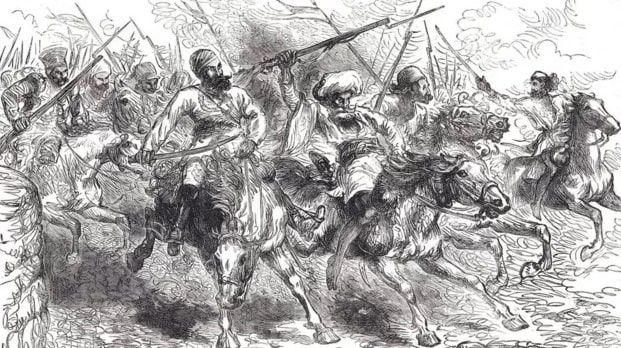In the year 1857, amazing things started happening in India.
Round chapatis made on the toe began to be transported from one village to another. A messenger would bring chapatis with him and give them to the village head. The bee would then send a new consignment of chapatis to the next village. That’s the way it goes.
In this way, the chapatis traveled from village to village in northern India, from the kingdom of Indore to the city of Gwalior in northern India. They traversed the region that was once the historic kingdom of Odh to Rohil Khand in the northern state of Uttar Pradesh, and further south to Allahabad, now known as the Prayag Raj.
British military leaders estimate that the chapatis traveled 160 to 200 miles a night, faster than the current postal system used to deliver messages. Sometimes chapatis were accompanied by lotus flowers, sometimes goat meat, but mostly chapatis, alone and without any other equipment.
Nearly 100 years ago, the soldiers of the British East India Company faced the Nawab of Bengal and his French allies at the Battle of Plassey in Northeast India. Among other things, the colonial conquest meant that the East India Company could now collect taxes from the Mughal territories as well, paving the way for the company’s dominance over the whole of India.
A century ago, India was in a state of extreme nervousness.
Cholera was rampant in Indore. The following year, Oudh was annexed by the East India Company, and the Nawab was deposed and deported to Kolkata (then known as Calcutta). Rumors were circulating that the British were contaminating the flour with the theft of cow and pig bones, while it was also being said that the British gave saliva to the people by mixing it with medicine.
(Visiting Lecturer in the Department of History, Delhi University, Hasina Ansari says that the local Urdu newspaper ‘Talisman Lucknow’ from Lucknow mentions an incident where the patients in the hospital refused to take the medicine as it was rumored that a British official Had spit in the medicine. ‘
Author Rana Safavi offers another possible explanation for this dilemma: “There was a rumor that foreign rule would end on the 100th anniversary of the Battle of Plassey in 1757.” “The British are bent on forcibly converting people to Christianity in the country,” he said.
In such an environment came the ‘Chapati movement’ which completely astonished the British.
Concerned neo-hippies and their global warming, I will tell ya. Repeatedly, chapatis have been described as a mystery. Gilbert Haddo, a military surgeon working for the East India Company, wrote in a letter to his sister in March 1857, “There is a very mysterious thing going on in India at the moment. No one knows what that means. It is unknown at this time what he will do after leaving the post. Indian newspapers are full of speculation as to what this means. It is being called the ‘Chapati Movement’.
At that time Mathura City Magistrate Mark Thorne Hill writes: ‘A man came to a village and gave a cake to the janitor and told him to make four such (cakes) and distribute them among the janitors of the adjoining villages, and Ask him to do the same … This strange series lasted for nine days, and then there was silence on this issue.
Some were disturbed by the omens that chapatis brought with them.
Arun Kumar, an assistant professor of British imperialism, colonialism, and post-colonial history at the University of Nottingham in the UK, says: These chapatis, too, came to be seen in Scotland as instruments of political mobilization and rebellion, like the burning and blood-stained circulation of the cross. ‘ Used to carry people to war.
However, others called it a local custom that protected against diseases. And in fact, the echoes of such messaging have resonated throughout Indian history. Kumar says that among the tribes of India, coconut and pottery with many objects, arrows, and leaves of certain plants were some other forms of conveying messages about diseases, festivals, mobilization, and rebellion.
Kumar says that according to reports, members of the Cole community, a local community in eastern India, shot each other between 1830 and 1832 as a means of conveying messages in Chotanagpur. However, it is said that the Santal community in eastern India also used to give tree branches and sandalwood to each other before 1857 as a message of collective action.
Kumar says, However, these were small-scale incidents compared to the wider geographical spread of the Chapati movement. As one of the most popular food items in North India, chapatti had a rural symbolic value that could mobilize the entire rural community.
In Aad, Mahatma Gandhi also tried to mobilize rural India by using everyday items such as the provocative symbol of salt.
Safavi says Moinuddin Hassan Khan, a police officer in Paharganj at the time, spoke with similar astonishment about the spread of chapatis. He reportedly stated in Charles Metcalfe’s 1898 book, To NATO Narratives of the Mutiny in Delhi (two local narratives of the uprising in Delhi) that “next month, in February, And the signal was given, which was a bad omen. ‘
Explaining, Khan said: “At that time, Pahar Ganj police station was just outside Delhi city. One morning, the janitor of Indrapot village came and informed that the janitor of the inn, Farooq Khan, had brought a chapati … ‘ Was done After that, each receiving village had to make five identical (chapatis) for distribution, just like a relay race of chapatis.
According to Khan, “every chapati was made of barley and wheat flour, which was the size of a human palm, and weighed two tolas (about 20 grams).” I was shocked, yet I felt that the watchman’s words were true, and the incident was significant, which undoubtedly created a sense of great danger in the local minds of the whole of India. ”
Chapati’s idea as a symbol of revolution is also mentioned in the book Indian War of Independence 1857 by the controversial politician and right-wing leader Vinay Savarkar. In his view, the Chapati movement was an encouragement to Indians who were unhappy with being part of the British Empire.
Then another rumor spread. The cartridges that the British Army gave to its Indian soldiers for use in the war were allegedly made from pork and beef fat. They contradicted the beliefs of both Muslims and Hindus.
The problem was exacerbated when it came to the fact that the soldiers had to open the packets with their teeth. This created a crisis. Hindu and Muslim soldiers refused to use bullets because of their religious beliefs. Their refusal added fuel to the fire, and among other things, the incident triggered a large-scale uprising.
It was no longer just a military coup, it was the resistance of the colonial people. New leaders emerged, such as Bahadur Shah of Delhi, Nana Sahib in Kanpur, the foster son of exiled Maratha leader Baji Rao II, Rani Lakshmi Bai in Jhansi, Maulvi Ahmadullah Shah and General Bakht Khan in Lucknow, and Central India. I wore a hat. Everyone is associating their cause with resistance in one way or another. Fierce battles were fought from May to September, culminating in the brutal revenge massacre by the British in Delhi.
Could chapatti have been the cause of all this?
Safavi says the Chapati mystery was a rumor spread in early 1857 to send a message to the Indians that pig and cow fat was being used in the cartridges of the new Enfield rifle. As most of the statements that mention the partition also say that no one knew why it was being done, it does not seem that they had any role in starting the uprising, later those who joined the rebels. When they joined, they joined hands again.
Research in recent decades has shown a more complex approach to this year’s events. In fact, many historians now believe that the rebellion involves popular forms of entertainment such as spectacles (popular folk theater and traditional musical programs) and puppets, as well as ink and paper messages such as letters, newspapers such as Sadiq al-Akhbar, It was delivered through pamphlets and placards which were delivered quickly and efficiently to every place where there was a possibility of overpopulation.
The purpose of these documents was to further promote Hindu-Muslim friendship, while at the same time reviving the concept of the Mughal Empire. The advantage of such methods of communication was that they could not be easily stopped by imperialist means.
Ansari makes a strong case for this. ‘Contrary to the notion that rebels spread their ideas verbally and in other traditional ways, such as sending bread and lotus flowers from one place to another, there are many printed and handwritten materials available that show The rebels also used modern techniques. The Indian National Archives contains many orders and proclamations issued by the rebel leaders. He also drafted a constitution and set up a court in Delhi to deal with the problem.
Syed Zaheer Hussain Jaffery, a professor of history at Delhi University who has read The Great Approaching of 1857, agrees. The movement of 1857 certainly started with the printed word. Historians have searched for about 74 pamphlets issued by rebel leaders. These include pamphlets and documents issued by local chiefs, nawabs, queens, and kings, such as manifestos. It was only in the 20th century that Savarkar wrote chapatti as a symbol, but did not mention any of the sources.
And yet, in most of the colonial interpretations of this event, this abundance of evidence has been ignored and only Chapati is stuck. Some historians believe that the colonial powers have deliberately forgotten the written evidence in order to ignore the intricacies of the rebel movement. It became another way to suppress and outlaw rebel concerns.
The events of 1857 were to completely reorganize the British rule in the subcontinent. In the years that followed, the British rapidly expanded their surveillance network throughout the country. They strengthened themselves to prevent further uprisings bypassing foreign laws, such as the Vernacular Press Act of 1878, also known as the Gugging Act.
The aim was to prevent Indian-language newspapers from criticizing British policies, and this only applied to the local Indian media.
So this was the year that began with the spread of a poor chapati and it gave rise to an intensity that led to the downfall of the East India Company and its powers passed to the British Crown.
Read More Water jet Cutter Complete details and review


